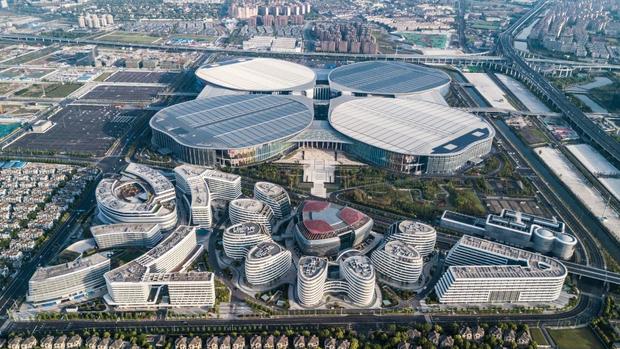 A bird's eye view of the National Exhibition and Convention Center (Shanghai), which is located in the Hongqiao central business district. (PHOTO PROVIDED TO CHINA DAILY)
A bird's eye view of the National Exhibition and Convention Center (Shanghai), which is located in the Hongqiao central business district. (PHOTO PROVIDED TO CHINA DAILY)
Shanghai will implement the country's new plan for an international hub in Hongqiao with 75 concrete measures to boost connectivity in the Yangtze River Delta and link domestic and global markets.
Chen Yin, executive vice-mayor of Shanghai, said on Wednesday that the development of the hub will focus primarily on transportation, exhibitions and conventions, and business services.
"The approval of the international hub by the State Council made it one of the important places, along with the Lingang Free Trade Zone and the Yangtze River Delta demonstration zone, that will be used to carry out the national strategy of the integration of the Yangtze River Delta," he said.
The hub is expected to cover 7,000 square kilometers, which includes the 151-sq-km core area of Hongqiao's central business district and two extended strips connecting Suzhou, Jiangsu province, and Haining, Zhejiang province.
"We will strive to create an international central business district in Hongqiao, set up a new platform for an international trade center, improve comprehensive transport management and serve the Yangtze River Delta while also linking with the world," Chen said.
Chen Yin, executive vice-mayor of Shanghai, said on Wednesday that the development of the hub will focus primarily on transportation, exhibitions and conventions, and business services
ALSO READ: Hongqiao CBD to become locomotive for development
Wang Huajie, deputy director of the Shanghai Municipal Development and Reform Commission, said Shanghai will implement 29 policies, including normalizing the facilitation of customs clearance and transaction settlement policies launched for the China International Import Expo, as well as reforming visa and residential policies for foreign talent.
A total of 33 platforms, such as the Hongqiao International Economic Forum, exhibition centers and industrial parks for high-tech companies, will either be built or enhanced, Wang said.
In addition, Shanghai will launch another 13 major infrastructure projects, including the construction of new high-speed and intercity railway lines as well as connections between existing lines with neighboring provinces, according to the Shanghai Municipal Transportation Commission.
Zhang Wuan, vice-president of Spring Airlines, which is headquartered in Hongqiao, said the company has already benefited from its location advantage, and 80 percent of its flights have resumed operation despite the COVID-19 pandemic.
READ MORE: Plan gives Shanghai's Hongqiao a big boost
"Building a Hongqiao international hub will help us attract more talent and capital and go global," Zhang said.
Xu Qing, chief financial officer of Messer Group China, said the company, a branch of a German enterprise, was promoted to serve as the headquarters for the Asia-Pacific region last year.
"We are based in Hongqiao and do business across the region," Xu said.
"The convenient transportation options have increased our efficiency when we go to meet clients in other cities in the Yangtze River Delta or other places."
Shanghai first established the Hongqiao central business district in 2009 when construction of the Hongqiao Comprehensive Transportation Hub-combining its airport, railway and metro stations-was completed.
In 2014, the National Exhibition and Convention Center (Shanghai), the world's largest exhibition complex, was built in the business district. It began hosting the annual China International Import Expo in 2018.
Shen Weihua, deputy director of the Shanghai Municipal Commission of Commerce, said it will raise the level of reform and opening-up by expanding the spillover effect of the CIIE, supporting new forms of international trade-such as cross-border e-commerce and offshore trade-and attracting more companies to found their headquarters in the area.


